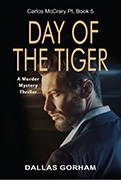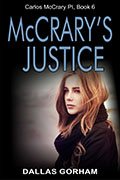Sneak Peak at Dallas Gorham’s Next Book: Echoes of War

I’m writing the first draft of my ninth Carlos McCrary mystery/thriller, tentatively titled Echoes of War.
The story opens with a body washing up on a deserted beach on Rockfish Key. The headless corpse has 777 tattooed on one arm. Could the murder victim be a former member of Chuck McCrary’s Triple Seven Special Forces unit? Chuck and his friend, Port City Police Captain Hidalgo “Hank” Ramirez, travel to the Port City Police Crime Lab to help identify the body.
This is the first time I’ve featured Chuck’s former Special Forces commander Hank Ramirez in a novel. You met Hank in “I’m No Hero,” my short story introducing Carlos McCrary when he was a sergeant in the Special Forces. I hope you’ll enjoy getting to know Hank better.
In Chapter 3 of Echoes of War Chuck and Hank Ramirez visit the Port City Police Crime Lab. I do a lot of research for my novels online, of course. To get a feel for how a big city crime lab operates, I found a fascinating video on YouTube entitled Inside the Crime Lab: A Complete Tour of the Denver Police Crime Laboratory. Click on the link if you’d like to see a twenty-six-minute tour of the Denver crime lab.
The autopsy scene and the crime lab scene will be realistic, but not gory. I keep my stories to a PG-13 rating and don’t create any scenes with images that will keep anyone up at night. It takes a deft touch to write this way, but—with help from my editor—we succeed.
I’ll keep you abreast of how Echoes of War is proceeding.
Book Titles Should Send Useful Clues to Readers
It’s been said that you can’t tell a book by its cover. That’s hogwash. (I would have used an earthier expression starting with a B, but this is a family blog.) In the real world of real buyers, most people form their first opinion about a book by its cover. While I enjoy the creative process of writing a book and telling a compelling story, I also try to make a good living doing it. Sales in the marketplace are a good measure of how much people like my work. So I want to sell books—lots of books, thousands of books.
My book covers and titles send important messages to potential buyers who are considering my books. You, the reader, may invest five or ten hours to read a book. Your time has a value, and you’re gambling more than the purchase price when you buy my books.
One of the challenging aspects of marketing any book is to choose a title that people will click on. I want my titles to say, “Yes! That looks interesting. I want to learn more about this book.” My books are only available on the internet. On the internet, people don’t read; they scan. I can’t afford to make you, the buyer, work to figure out the meaning of my title. I have to grab you quickly, or you’ll move on to some other writer.
I want my titles to be short, but I want you to instantly understand what my books are about.
For example, I wrote my first novel using the working title of The Accidental Heiress. Bad idea: Too many friends told me that it sounded like a romance novel. One of my sisters-in-law reads a couple of #romance novels a week. Now I would love to tap into a market that deep and rich, but I prefer to write #mysteries and #thrillers. I went back to the drawing board and brainstormed new titles. I even surveyed a few of my fellow writers and readers (including my sister-in-law).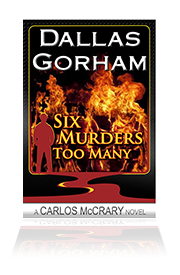 I selected Six Murders Too Many. That tells the reader that this is a #mystery. It also says that it has lots of action. And the cover design with the burning house is a real attention-grabber. If I had gone with my original title, it would probably have been a dud seller.
I selected Six Murders Too Many. That tells the reader that this is a #mystery. It also says that it has lots of action. And the cover design with the burning house is a real attention-grabber. If I had gone with my original title, it would probably have been a dud seller.
My second novel, Double Fake, Double Murder 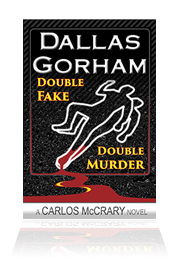 was originally going to be titled just Double Fake. A title search on Amazon revealed that there were two other books with “double fake” in the title. They were both about soccer. So I added “double murder” to the title. Now anybody can tell that this is a mystery, not a soccer guide. And I love the double outline of two bodies on the cover. Mike Butler, my cover designer, came up with that one. Great idea, Mike!
was originally going to be titled just Double Fake. A title search on Amazon revealed that there were two other books with “double fake” in the title. They were both about soccer. So I added “double murder” to the title. Now anybody can tell that this is a mystery, not a soccer guide. And I love the double outline of two bodies on the cover. Mike Butler, my cover designer, came up with that one. Great idea, Mike!
Quarterback Trap, the third Carlos McCrary novel, was so obvious that the title almost selected itself.  The star quarterback of the upcoming Super Bowl game has his fiancée kidnapped by mobsters who have a huge bet on the game. The star quarterback felt trapped. Duh… The title was a piece of cake. And the cover of a gun over-shadowing a football stadium tells a great story by itself.
The star quarterback of the upcoming Super Bowl game has his fiancée kidnapped by mobsters who have a huge bet on the game. The star quarterback felt trapped. Duh… The title was a piece of cake. And the cover of a gun over-shadowing a football stadium tells a great story by itself.
Dangerous Friends was a tough choice.  I’m still not crazy about the title, but at least the word “danger” tells the buyer that this is a #thriller. The “dangerous friends” are eco-terrorists that dupe an idealistic college student into committing a #terrorist act. If you think of better title, let me know. The cover image shows a key scene from early in the book that starts the whole thriller on its whirlwind roller-coaster ride to the finish.
I’m still not crazy about the title, but at least the word “danger” tells the buyer that this is a #thriller. The “dangerous friends” are eco-terrorists that dupe an idealistic college student into committing a #terrorist act. If you think of better title, let me know. The cover image shows a key scene from early in the book that starts the whole thriller on its whirlwind roller-coaster ride to the finish.
In my next blog I’ll cover my latest book, Day of the Tiger.
Inside the black tent (where the magic happens)
I just sent my fifth novel Day of the Tiger to the editor.
I had been chained to my desk, pounding my keyboard until my fingernails bled, for virtually the entire month of January in order to finish the manuscript by the January 31 deadline. This outrageously tight deadline was impo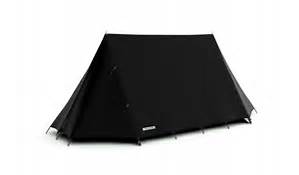 sed by the harshest taskmaster I’ve ever slaved under–me. I unlocked the door to my office (where all the magic happens) only when I emerged for another #caffeine fix or the occasional crust of stale bread with crunchy peanut butter and raspberry-jalapeno jelly. Then I would tell myself, “Eat fast, then get back to work.” I pounded out between 2,000 and 4,000 words most days, working from about 8:00 a.m. to 6:00 p.m.
sed by the harshest taskmaster I’ve ever slaved under–me. I unlocked the door to my office (where all the magic happens) only when I emerged for another #caffeine fix or the occasional crust of stale bread with crunchy peanut butter and raspberry-jalapeno jelly. Then I would tell myself, “Eat fast, then get back to work.” I pounded out between 2,000 and 4,000 words most days, working from about 8:00 a.m. to 6:00 p.m.
Should be available in March. Egad! That’s next month!
I write for three reasons: First, it’s a lot of fun to create an entire world with people, buildings, climate, cities, politics and so forth, all from my own goofball mind. Second, I like to make the world a better place by giving people something entertaining and uplifting. A place where the good guys win, right triumphs, and the bad guys get what’s coming to them. Ah, if only the world were really that way all the time. Third, I hope to make a pot full of money from my writing.
People often ask where I get my ideas.Some people think that a successful #writer comes up with a good idea, then goes into a black tent, does some magic, and emerges later with a well-crafted, entertaining book for them to read.
Creating the idea is the easy part.
If all it took to write a good book was to have a good idea, then anybody could do it. That’s like saying “Anyone with a set of #golf clubs can play on the #PGA or #LPGA Tour.” It is true that anyone can play golf. In fact, I played nine holes earlier this week. But not just anyone can play golf well. There are a gazillion duffers like me. We hack around from rough to bunker to lake and eventually get the little white ball (or in my case, the little optic yellow ball) in the hole. But there are precious few players like my fellow Texas Longhorn Jordan Spieth. These men and women look at par in their rear-view mirror while they blaze their way around the course with the skills to make it look oh, so, easy. Anyone who’s ever played golf knows that it’s a lot harder than it looks.
Writing is the same as playing golf. Anyone with a computer and an internet connection can write and publish a book. And hundreds of thousands of people have done so. It doesn’t even cost anything. So it’s true that anyone and everyone can write. But to write well… Ah, that’s another thing.
Having a good idea for a plot is about ten percent of what’s needed to write a good book. The other ninety percent is to tell that story in a way that entertains the reader and keeps him or her wanting to read more books by the talented author. Think of Robert B. Parker, Robert A. Heinlein, Mickey Spillane, Agatha Christie, and John D. MacDonald of the fiction world. And those are just a few of the great, but unfortunately dead, writers whom I admire. I didn’t mention any living authors because I have so many favorites and I wouldn’t want to inadvertently leave anyone out. Thousands of raving fans would buy and read everything these fiction giants wrote. I hope someday I can earn half the fan loyalty these men and women earned.
Inside the black tent
I’m going to lift the wall of the black tent and show you how I made the magic happen with my most recent attempt at literary immortality, The Day of the Tiger.
My first draft followed the principal of “Dump it on the page and get the basics of the story right.” I met a fellow writer who wore a tee-shirt that said, “I don’t care if it’s crap; just get it on the page.” That’s my motto because you can’t improve a story that’s not written. Until you have a completed story, you don’t have a product–not even a bad product. Some famous writer whose name escapes me once said, “Every good novel began as a lousy first draft.”
In this case, my lousy first draft ran 77,787 words. That took about four solid weeks chained to my desk.
I finished the first draft, patted myself on the back, admired this work of genius for about three seconds, then plunged into the second draft.
To write the second draft, I read the first draft aloud to see how the words sounded. I know that you don’t move your lips when you read. But even when you read silently, you hear in your mind how the words sound. I want my words to sound well in the reader’s head. I read the first draft aloud and stopped when something didn’t flow just right. I made the changes to the draft and kept reading. That took two days to read, change, and create the second draft.
The second draft ran 79,809 words. That means that I had to add about 2,000 more words to make the words flow smoothly.
And, yes, I did get hoarse reading aloud for over twelve hours.
To write the third draft, I ran the second draft through a piece of software called Smart Edit, available from Bad Wolf Software. Smart Edit is the best fifty bucks I ever spent, if you don’t count the money I spent on my first date with the woman who is now my wife. Smart Edit looks for things like overused adverbs, repeated phrases, misused words (such as their when you mean there), clichés, redundancies, proper nouns (to make sure I don’t call a character Monty one time and Marty the rest of the time), and so forth. One real-life catch: There is one setting where my fearless hero Carlos McCrary drops off the ransom for the kidnapping victim. In one chapter I called it “Fisherman’s Pier” and in another chapter I called it “Fishermen’s Pier.” You might think that’s a nit-picky difference, but excellence in writing is a game of inches.And if you were the reader who noticed the inconsistency, it could affect your opinion of the quality of my work overall. Perish the thought.
The third draft had 78,626 words and took another two days.
The fourth draft was a bitch. It took just over a week to go through my “List of words to restrict use of.” It’s a list of over fifty words or parts of words that writers sometimes overuse: about, almost, also, anyway, can or could, get, going or going to, etc. See my blog of How to be a better writer–words to avoid. That original list had only 41 items on it. Now I have over fifty.
That draft wound up with 74,216words.
Then I print the fourth draft, sit in my easy chair, and read it just like you would (except I have a ballpoint pen in my hand). That was 211 pages of 8-1/2 by 11 paper. I discovered some parts in an earlier chapter that I moved to a later chapter where the flow of the action made more sense. Those corrections took another two days and resulted in the fifth draft, which had 74,166 words.
That’s the one I sent to my #editor.
A word or two about my editor, Marsha Butler: Marsha makes me a better writer. Yes, she does line edits like any other editor, but that’s not all. She also reads the book. She has opinions on what works, what doesn’t, and how to make my manuscript better. Every writer should be lucky enough to find an editor like Marsha. Her website is butlerink.com. Check it out.
It’s not magic after all
So it’s not just getting a good idea and waving a magic wand. It’s hard work, sweat, pacing the floor, taking a break to let my mind unclench, and a lot more. Yes, my mind clenches after a few hours of uninterrupted writing. Thank goodness for lunch and coffee breaks.






